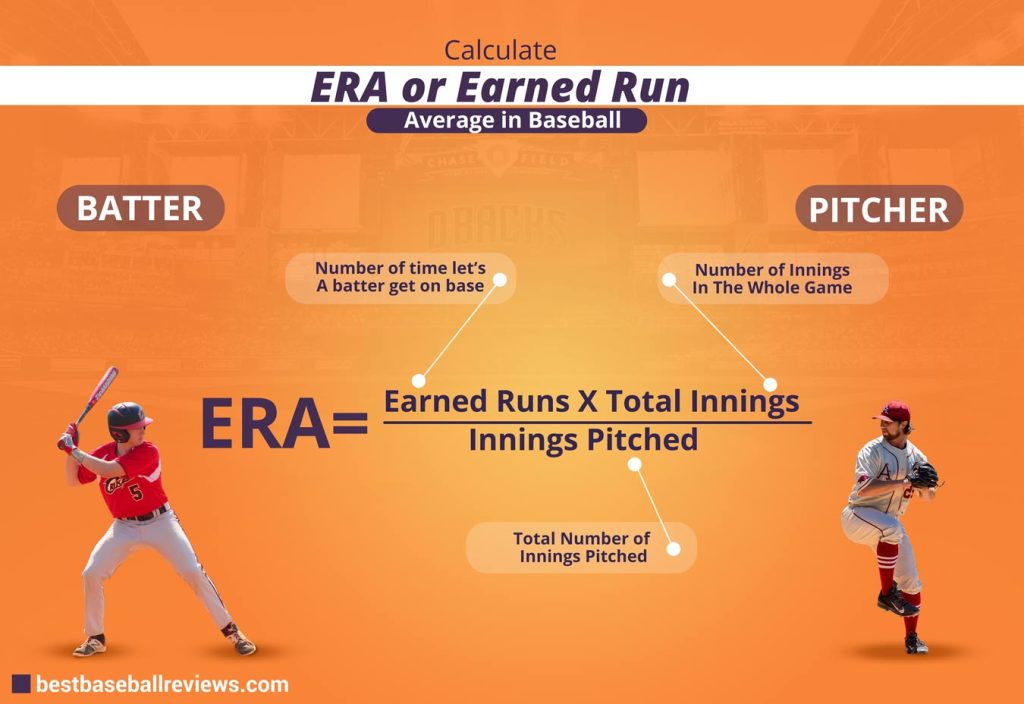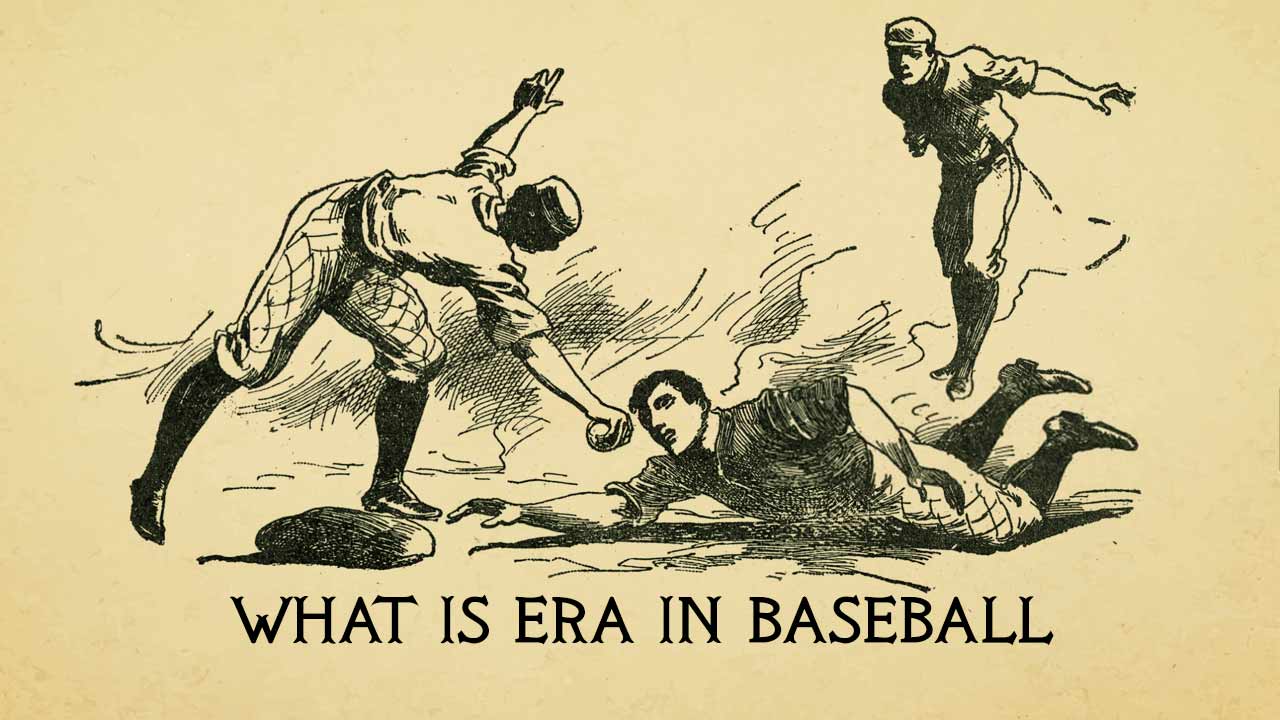In the long history of baseball, figuring out a way to measure a player’s effectiveness has been an issue. The players, coaches, sponsors, and fans alike wanted to know how good a player was. They needed ERA to figure out who was the best pitcher in baseball.
As the years went by, methods to figure that out came to be. But, in reality, out of all the players on the field, the pitcher is the one that gets the most attention. In fact, a pitcher is one of the most significant assets of a team. Therefore, Earned Run Average (ERA) creation was to help gauge pitcher success.
Table of Contents
What does ERA mean in Baseball?
Earned Run Average, or ERA in baseball, is a statistic that shows how many earned runs a pitcher allows in nine innings. It is calculated by dividing the number of earned runs by the total number of innings pitched, then multiplying it by nine.
While ERA may seem like a really useful tool, it isn’t enough to show how good a pitcher is. In fact, you will need to look at multiple stats at once to determine the pitcher’s capabilities. Therefore, we need a deep dive into ERA and decipher it for better understanding.
When did ERA come to be in Baseball?
ERA’s introduction to baseball is thanks to a numbers man. Statistician and fellow writer Henry Chadwick gets the credit for thinking up an ERA in the latter half of the 19th century. He wanted to find a better way to represent a pitcher’s success other than the win-loss ratio.
Finally, the ERA stat caught on until the 20th century due to the emergence of relief pitchers or relievers, pitchers that come after the starting pitcher is removed. Relief pitchers made the win-loss record even less reliable. This is because a starting pitcher may have played a great game. But the relief pitcher may cause some errors, causing losing the game; thus, the starting pitcher’s record would suffer.
In 2022 we had an unofficial set ERA such that below 4.00 is good while below 3.00 is excellent. If a pitcher has an ERA below 2.00, he is good enough to be in the Hall of Fame. Conversely, above 4.00 or 5.00 ERA signifies a poor or inexperienced pitcher.
Earned Run Average became the norm as an official MLB statistic in 1912. Recently, the method of referencing a pitcher’s ERA goes something like this: “He is 2-2 with a 2.96 ERA.”
What is an Earned Run in Baseball?
Chiefly, there is a simple distinction between earned and unearned runs. An earned run is scored only because of a pitcher’s pitching capabilities. It considers the strategies used by the offensive team to defend the other team. In general, poor defense can allow for many runs and lower the pitcher’s effectiveness.
In Major League Baseball, earned runs are the most common. Finally, in the 2019 MLB season, the percentage of earned runs rose to 92% plus. All of those runs were slowly from a combo of hits, walks, and hit batters, as well as timed out.
What is an Unearned Run in Baseball?
An unearned run is recorded due to an error or a passed ball. The cause of these unearned runs is primarily due to the fielder’s error, such as the passed ball. Fault on the pitcher’s side is also present, but it isn’t due to their pitching capabilities.
Just as these runs are typical, unearned are very much not standard.
For example, in the same 2019 MLB season, only about 1700 runs went unearned. Using that number, we can statistically say that in the 2019 MLB season, for every four MLB games, there can be three unearned runs.
Now that we accurately differentiate between earned and unearned runs, we can now focus on, how do you calculate Earned Run Average (ERA).
How to calculate ERA or Earned Run Average in Baseball?
While the ERA calculation equation is relatively easy, you might need some time to familiarize yourself. I needed to use it a few times to get it to hang.
So ERA calculation for a pitcher happens by dividing the number of earned runs out of nine innings by the total number of innings pitched. Then multiply that number by nine.
The equation looks like this:
ERA = (earned runs / total number of innings pitched) *9

For a better understanding, let’s put the equation to the test. Let’s make an imaginary pitcher and have him pitch for 40 innings. In those 40 innings, he got, let’s say, 20 runs, but unearned runs number at 3, so his earned runs number at 17.
Thus, our imaginary pitcher has 17 earned runs in 40 innings, which gives us 0.57. Multiply 0.43 by 9, and our fictional pitcher’s ERA stands at 3.825. ERA’s are often shown to two decimal places; thus, the final ERA is 3.83.
Let us put this number to good use and see what it means.
What is a good MLB Bullpen Earned Run Average (ERA)?
ERA doesn’t have a number set in stone that indicates who has a good ERA above others. Instead, the ERA value fluctuates all over the place due to a series of factors at any given time.
In particular, things such as the quality of pitchers, the number of innings played, ballpark dimensions, and even minor items like mound elevation play a part. Unofficially, though, there is a benchmark of sorts in terms of ERA.
In 2022 we had an unofficial set ERA such that below 4.00 is good while below 3.00 is excellent. If a pitcher has an ERA below 2.00, he is good enough to be in the Hall of Fame. On the other end, above 4.00 or 5.00 ERA is a sign of a poor or inexperienced pitcher.
The 2019 Major League Baseball season saw that ERA in the league was 4.49. That’s a lousy number for us baseball fans. Meanwhile, our imaginary pitcher had an ERA for the season of 3.83, so he was doing good. His ERA was 25% below the league average. Way to go, our imaginary pitcher that I didn’t even bother to name!
The lowest recorded league-wide average ERA by year was in 1908. The start of modern baseball (pun intended!) was in 1901. The 1908 season saw the ERA to be at 2.37. If our player had 3.83 as his ERA during that season, his score would be 38% above the rest. That would have led to some hazing for our imaginary pitcher.
What is a good ERA?
Since the start of the 21st century, record-keeping and average calculation have begun. The annual average ERA in the MLB league stands at around 2.37. Now that’s a number to be proud of, wouldn’t you agree?
According to baseball-reference.com, those at the top of the lowest all-time career leaders’ ERA chart have their ERA at around 1.66-2.77. Only two are on the active roster in the top 50 of the list. Clayton Kershaw and Jacob deGrom are the only two with an ERA of 2.467 and 2.502.
The question of who has the best era in baseball is something many people talk about. The answer to the question of who earned the best era is one man. Ed Walsh has held the title of the best era after a 14-year career with an ERA of just 1.82!!
Below we have provided an easy-to-understand table of the highest and lowest ERA recorded in MLB history. The list contains the names of players with the highest and lowest career ERA in MLB history. Remember that the lower the ERA is, the better.
ERA Range in MLB in 2023
Rating | Range |
Extraordinary | 2.00 ≤ |
Outstanding | 2.00-3.00 |
Above Average | 3.00-4.00 |
Average | 4.00-5.00 |
Below Average | 5.00-6.00 |
Weak | 6.00 ≥ |
The Best ERA
Rank | Name | ERA |
1 | Ed Walsh | 1.816 |
2 | Addie Joss | 1.887 |
3 | Jim Devlin | 1.890 |
4 | Jack Pfiester | 2.024 |
5 | Joe Wood | 2.030 |
The Worst ERA
Rank | Name | ERA |
1 | Les Sweetland | 7.71 |
2 | Jim Deshaies | 7.39 |
3 | Jack Knott | 7.29 |
4 | Jose Lima | 6.99 |
5 | LaTroy Hawkins | 6.66 |
ERA Tidbits
- Every pitcher is “responsible” for the runners on base even after leaving. So if a pitcher scores a run legitimately, then the original pitcher that he hit would have their ERA changed.
- ERA puts more emphasis on strong defense than speed and pitching skills. Relief pitchers or pitchers that make shorter appearances are made to look much better than other “better” pitchers with weaker defense.
- During 1900–1919, an ERA of 2.00 was said to be a good score. From 1920–1960, the Golden Age of Baseball, the standard was changed to 3.00–4.00. This ERA standard is still in effect today.
Frequently Asked Questions(FAQs)
What is better high ERA or low ERA in baseball?
Unlike some other stats in baseball, having a lower ERA is always better for pitchers. A low ERA is an indicator of a pitcher who is capable of allowing fewer runs per hitter.
Pitchers with an ERA between 3.00 and 4.00 in 2023 are better than most.
What does ERA calculate in baseball?
The calculation of ERA in baseball is quite simple; you can do it by hand. You must calculate the number of earned runs, innings played, and pitched. Then multiply the earned runs by innings played and divide that by innings pitched.
When did ERA come to be in baseball?
Henry Chadwick is the man that came up with the ERA during the late 19th century. However, it became popular in the 20th century due to relief pitchers in baseball.
Is a ERA of 0.0 possible in baseball?
Zero ERA is only seen during the start of the season since there aren’t any stats to measure it. Zero ERA also goes by undefined or infinite ERAs.
Conclusion
By this point in the article, you should be able to answer what is ERA in baseball and what its significance is. A fun thing you and your friends can do is calculate your ERA with the formula we gave you and compare them with each other and your favorite pitcher.
I hope all readers will now calculate your ERA and compare them to your favorite pitcher. It is a good tool for seeing a pitcher’s strength while considering some factors. While there won’t be an all-encompassing tool, ERA, for now, gets the job done.
Alongside ERA are numerous baseball stats for pitchers, hitters, and fielders alike. For example, we have Cycles and RBI for hitters, WHIP, PO, and FPS for pitchers and fielders.



